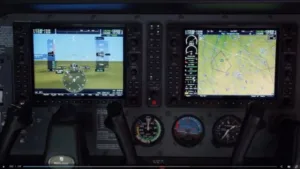In yesterday’s Display Daily, I wrote about glass cockpits in commercial and military aircraft. These airplanes aren’t the only ones that have replaced their conventional aircraft instruments with electronic displays driven by computers. This transition has happened in small, private aircraft as well.

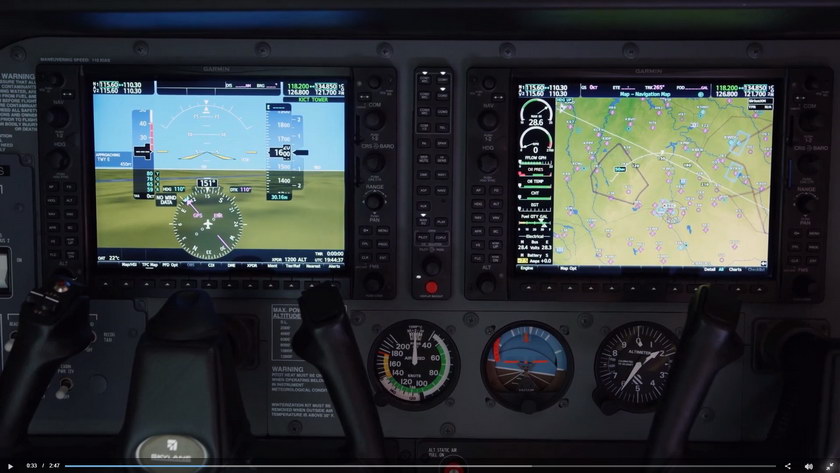 The Garmin G1000 NXI glass cockpit and integrated flight deck is used in the Cessna 172 Skyhawk and other small planes. (Credit: Textron Aviation)
The Garmin G1000 NXI glass cockpit and integrated flight deck is used in the Cessna 172 Skyhawk and other small planes. (Credit: Textron Aviation)
For example, the Garmin G1000 NXI integrated flight deck avionics package, including two LCD displays, is available in the Cessna 172 Skyhawk from Textron Aviation as an option: conventional instrumentation packages are still available. Reportedly, however, most buyers of new Skyhawks buy the glass cockpit version. As you look at the image, you can see three back-up conventional instruments below the glass cockpit displays. From left to right they are the airspeed indicator, an attitude gyro and an altimeter. None of these require electrical power except for illumination at night. The airspeed indicator and altimeter do not require any power at all and the attitude gyroscope is powered by a vacuum system. These back-up instruments allow a (skilled) pilot to safely fly the plane, even with a total electrical failure.
The Garmin G1000 NXi provides most of the functions that a user of a high-end smartphone would expect. It will communicate via radio and shows the currently tuned radio frequencies on the display screen. The system has a large memory that contains maps and other information for both visual flight rules (VFR) and instrument flight rules (IFR) navigation. These maps also have terrain information, which can be color coded onto the maps, if desired by the pilot. The G1000 NXI talks wirelessly to the pilot’s smartphone or tablet for updates to this map data. Flight plans can also be uploaded from smartphone or tablet into the integrated flight deck prior to take off. Optionally, the system has access to aviation weather reports in real-time. A short video showing these and other capabilities of the G1000 NXI is available here.
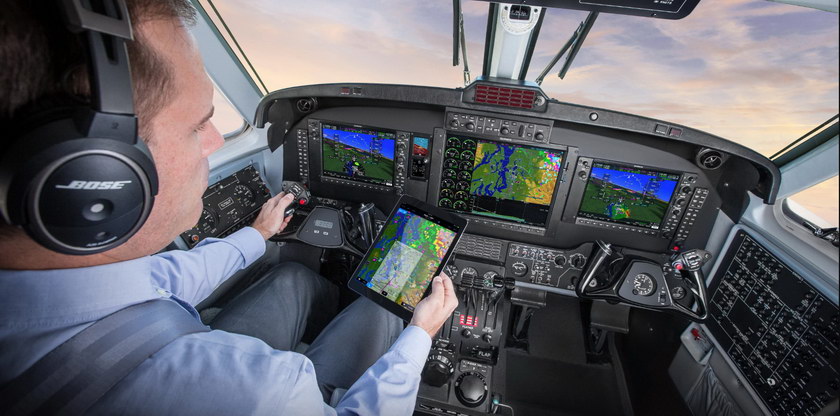 The King Air version of the Garmin G1000 NXI integrated flight deck has three main displays. Note: the very wide-angle lens used to generate this photo distorts the image. The pilot isn’t that big and the G1000 NXI isn’t that small. (Credit: Garmin)
The King Air version of the Garmin G1000 NXI integrated flight deck has three main displays. Note: the very wide-angle lens used to generate this photo distorts the image. The pilot isn’t that big and the G1000 NXI isn’t that small. (Credit: Garmin)
When the G1000 NXi was introduced in 2017 as a successor to the G1000 integrated flight deck, it was initially approved by the FAA for use in the twin-engine Beechcraft King Air 300/350, also from Textron Aviation. Since then it has been approved for multiple other aircraft, including the Cessna 172. Garmin said that in new King Air 300/350s, the G1000 NXI saved about 250 pounds (114kg) or more, compared to conventional instrumentation. For a small airplane, 250 pounds is a huge amount and this allows flexibility for additional baggage, passenger and/or fuel load. In the larger, twin engine King Air, the G1000 NXI has three main displays, instead of the two shown in the image above of the Cessna 172 version of the system.
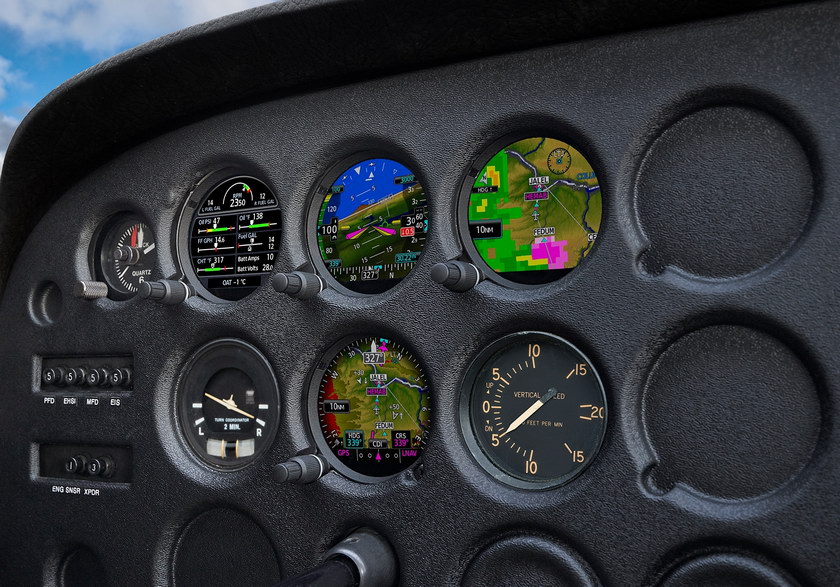 Four GI 275 electronic flight instruments installed in the panel of a Cessna 172. (Credit: Garmin)
Four GI 275 electronic flight instruments installed in the panel of a Cessna 172. (Credit: Garmin)
If you have an older Cessna 172 with older, conventional instruments but would like to upgrade, don’t worry. Garmin announced in January 2020 the availability of the GI 275 electronic flight instruments. These units are use the standard 3.125-inch (7.9cm) form factor and rear-mount design of older individual instruments to minimize panel modification when they are installed. These units also have battery back-up and are approved by the FAA for use as back-up instruments in full glass cockpits. For example, they could be used to replace the conventional back-up instruments in the Cessna 172 in the top photo. Multiple versions of the GI 275 are available and, when multiple units are installed, they all talk to each other to provide integrated functionality.
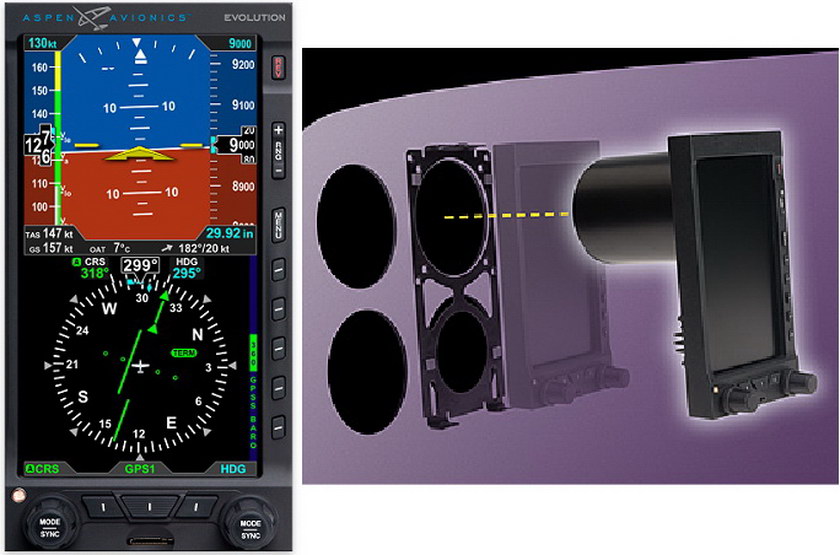 Left: Aspen Avionics Evolution E5 Electronic Flight Instrument (EFI). Right: Retrofitting the Evolution E5 into a cockpit with standard 3.125” holes. (Credit: Aspen Avionics)
Left: Aspen Avionics Evolution E5 Electronic Flight Instrument (EFI). Right: Retrofitting the Evolution E5 into a cockpit with standard 3.125” holes. (Credit: Aspen Avionics)
If you have an older airplane and want to upgrade to modern instruments but don’t like Garmin for some reason, you have other choices. For example, in January 2020, Aspen Avionics also announced an upgrade to their Evolution E5 Electronic Flight Instrument (EFI) which had been originally introduced in 2018. Like the Garmin Gi-275, the system is designed to fit in the standard 3.125” holes. It actually uses two adjacent holes and each instrument has multiple functions. In addition, multiple Evolution E5 units will talk to each other, providing an integrated system.
Safety is always a major consideration in aircraft, whether they are commercial aircraft carrying hundreds of people or private planes only carrying a few. In 2010, the National Transportation Safety Board (NTSB) released a study on the use of glass cockpits in private aircraft. The study looked at the accident rates for 8,000 small piston-powered airplanes manufactured between 2002 and 2006. The study was initiated to determine if light airplanes equipped with digital primary flight displays, often referred to as “glass cockpits,” were inherently safer than those equipped with conventional instruments.
The results of the study were a disappointment: it found there was a higher rate of fatal accidents in light aircraft equipped with glass cockpits than in aircraft with conventional cockpits. NTSB Chairman Deborah Hersman, when announcing the results of the study, highlighted the role that training plays in preventing accidents involving these airplanes.
“As we discussed today, training is clearly one of the key components to reducing the accident rate of light planes equipped with glass cockpits, and this study clearly demonstrates the life and death importance of appropriate training on these complex systems. We know that while many pilots have thousands of hours of experience with conventional flight instruments, that alone is just not enough to prepare them to safely operate airplanes equipped with these glass cockpit features.”
So be warned: if you upgrade your airplane or transition to a new plane with a glass cockpit, make sure you get all the training available and, if possible, more than that. – Matthew Brennesholtz

